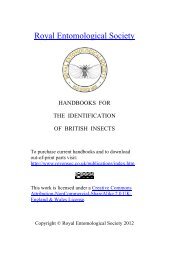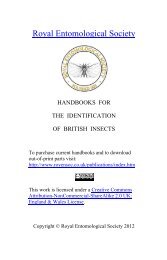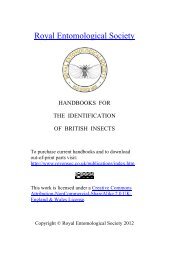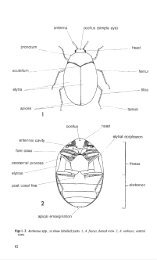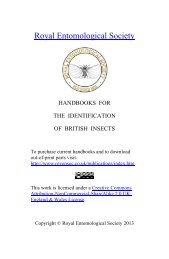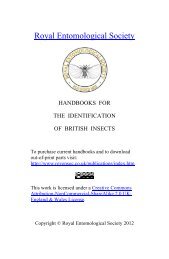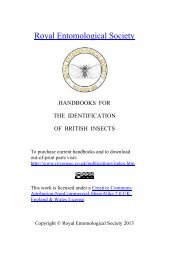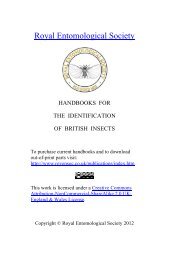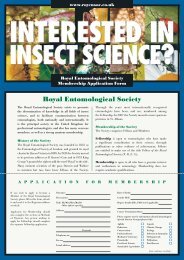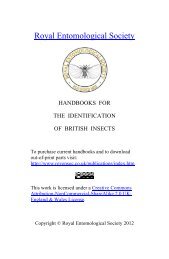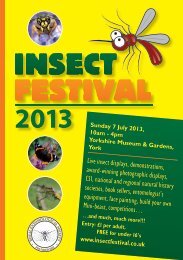Vol 10 Part 14. An introduction to the immature stages of British Flies ...
Vol 10 Part 14. An introduction to the immature stages of British Flies ...
Vol 10 Part 14. An introduction to the immature stages of British Flies ...
Create successful ePaper yourself
Turn your PDF publications into a flip-book with our unique Google optimized e-Paper software.
for higher degrees. This has resulted in several valuable and comprehensive studies, e.g.<br />
Dixon (1960) and Hartley ( 1961) on Syrphidae; Okely ( 1974) and Pitkin ( 1988, in part)<br />
on Sphaeroceridae.<br />
Unfortunately all families do not lend <strong>the</strong>mselves <strong>to</strong> concentrated short term study<br />
and may require a long and continuous effort before a reasonably comprehensive<br />
treatment can be achieved, e.g. Brindle's work on Tipulidae (1952- 1967) and <strong>the</strong> 25<br />
years required <strong>to</strong> produce Skidmore's (1985) book on Muscidae. Some fine work has<br />
been done in Europe especially by Dusek & Laska (1967, summary) on Syrphidae, and<br />
Hennig (1943a-1956) and Schumann (1953- 1974) on Cyclorrhapha.<br />
The identification <strong>of</strong>larvae beyond family level has thus remained a difficult process<br />
requiring a knowledge <strong>of</strong>, and access <strong>to</strong>, a very widely scattered literature. In this<br />
Handbook keys <strong>to</strong> families and sub-families <strong>of</strong> final stage larvae are given as far as this is<br />
possible. In some families fur<strong>the</strong>r keys and illustrations are given <strong>to</strong> facilitate identification<br />
<strong>to</strong> genera and sometimes <strong>to</strong> species. For <strong>the</strong> latter <strong>the</strong> aim has been <strong>to</strong> include<br />
species <strong>of</strong> medical and economic importance, species commonly involved in <strong>the</strong> everyday<br />
enquiries <strong>of</strong> environmental health <strong>of</strong>ficers or <strong>the</strong> general public (including non<br />
<strong>British</strong> species regularly introduced in imported food, etc.) and those species most<br />
frequently encountered as larvae during ecological surveys or <strong>of</strong> special value in teaching<br />
biology at school or university level. To fur<strong>the</strong>r <strong>the</strong>se aims some bionomic keys are<br />
given at appropriate points where a limited number <strong>of</strong> species occur in a restricted<br />
habitat. In a section on ecology <strong>the</strong>re are some listings <strong>of</strong> families, genera or species <strong>to</strong><br />
be found in specific habitats which, by restricting <strong>the</strong> possibilities, should facilitate<br />
more rapid identification by reference <strong>to</strong> <strong>the</strong> figures alone. A full index provides rapid<br />
access <strong>to</strong> ecological information in <strong>the</strong> text. There are brief general comments on eggs<br />
and pupae, and illustrations showing <strong>the</strong>ir diversity <strong>of</strong> form.<br />
The following comprehensive specialist works on larvae are <strong>of</strong> value in identification.<br />
Hennig (1948- 1952) is well illustrated and lists <strong>the</strong> world species described as<br />
larvae up <strong>to</strong> that time with a full bibliography. Peterson (1957) treats Nearctic species<br />
but Teskey (in McAlpine et al., 1981) does so in much greater detail. Seguy (1950)<br />
gives much detailed information on all aspects <strong>of</strong> fly biology arranged under subject<br />
and habitat and similar information for <strong>British</strong> species is given in Stubbs & Chandler<br />
( 1978) which includes a key <strong>to</strong> families <strong>of</strong> larvae (by Brindle & Smith). Brauns ( 1954)<br />
deals with terrestrial Diptera larvae and pupae and is well illustrated. Teskey<br />
(1984) gives a well-illustrated key <strong>to</strong> aquatic Diptera larvae. Oldroyd & Smith (in<br />
Smith, 1973) give a key <strong>to</strong> families <strong>of</strong> larvae <strong>of</strong> medical importance. Smith ( 1986) deals<br />
with species <strong>of</strong> forensic importance including those found on carrion (human<br />
and animal). Koppen ( 1972) covers some agricultural pest species. Askew (1971) and<br />
Clausen (1940) review parasitic Diptera. References <strong>to</strong> particular families are given in<br />
each section below.<br />
As this book goes <strong>to</strong> press a very important two volume work has appeared on <strong>the</strong><br />
<strong>immature</strong> <strong>stages</strong> <strong>of</strong> <strong>the</strong> Cyclorrhapha (Ferrar, 1987) and also part 2 <strong>of</strong> <strong>the</strong> Manual<br />
<strong>of</strong> Nearctic Diptera (McAipine et al., 1987), also covering Cyclorrhapha, has been<br />
published.<br />
Acknowledgements<br />
In his Introduc<strong>to</strong>ry Handbook <strong>to</strong> <strong>the</strong> Diptera <strong>the</strong> late Harold Oldroyd (1970b)<br />
expressed <strong>the</strong> hope that a volume dealing with <strong>the</strong> early <strong>stages</strong> <strong>of</strong> flies would eventually<br />
be produced in this series. Indeed, we had intended that we should cooperate in such a<br />
venture but his early death sadly prevented this. Never<strong>the</strong>less many <strong>of</strong> his ideas<br />
expressed both verbally and in his writings, especially in his unique book The Natural<br />
His<strong>to</strong>ry <strong>of</strong> <strong>Flies</strong> (1964), have stimulated an interest in <strong>the</strong> biology <strong>of</strong> flies among<br />
Dipterists, including <strong>the</strong> present author.<br />
4




